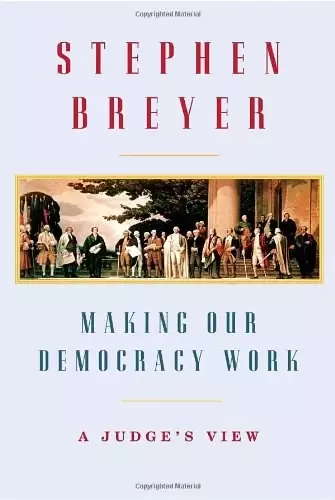
作者:StephenBreyer
出版社:Knopf
副标题:AJudge’sView
出版年:2010-9
页数:288
定价:USD26.95
装帧:Hardcover
ISBN:9780307269911
内容简介
· · · · · ·
The Supreme Court is one of the most extraordinary institutions in our system of government. Charged with the responsibility of interpreting the Constitution, the nine unelected justices of the Court have the awesome power to strike down laws enacted by our elected representatives. Why does the public accept the Court’s decisions as legitimate and follow them, even when those decisions are highly unpopular? What must the Court do to maintain the public’s faith? How can the Court help make our democracy work? These are the questions that Justice Stephen Breyer tackles in this groundbreaking book.
Today we assume that when the Court rules, the public will obey. But Breyer declares that we cannot take the public’s confidence in the Court for granted. He reminds us that at various moments in our history, the Court’s decisions were disobeyed or ignored. And through investigations of past cases, concerning the Cherokee Indians, slavery, and Brown v. Board of Education, he brilliantly captures the steps—and the missteps—the Court took on the road to establishing its legitimacy as the guardian of the Constitution.
Justice Breyer discusses what the Court must do going forward to maintain that public confidence and argues for interpreting the Constitution in a way that works in practice. He forcefully rejects competing approaches that look exclusively to the Constitution’s text or to the eighteenth-century views of the framers. Instead, he advocates a pragmatic approach that applies unchanging constitutional values to ever-changing circumstances—an approach that will best demonstrate to the public that the Constitution continues to serve us well. The Court, he believes, must also respect the roles that other actors—such as the president, Congress, administrative agencies, and the states—play in our democracy, and he emphasizes the Court’s obligation to build cooperative relationships with them.
Finally, Justice Breyer examines the Court’s recent decisions concerning the detainees held at Guantánamo Bay, contrasting these decisions with rulings concerning the internment of Japanese-Americans during World War II. He uses these cases to show how the Court can promote workable government by respecting the roles of other constitutional actors without compromising constitutional principles.
Making Our Democracy Work is a tour de force of history and philosophy, offering an original approach to interpreting the Constitution that judges, lawyers, and scholars will look to for many years to come. And it further establishes Justice Breyer as one of the Court’s greatest intellectuals and a leading legal voice of our time.
作者简介
· · · · · ·
Stephen Gerald Breyer (pronounced /ˈbraɪər/; born August 15, 1938) is an Associate Justice of the U.S. Supreme Court. Appointed by Democratic President Bill Clinton in 1994, and known for his pragmatic approach to constitutional law, Breyer is generally associated with the more liberal side of the Court.[1]
Following a clerkship with Supreme Court Associate Justice Arthur Goldberg in 1964, Breyer became well-known as a law professor and lecturer at Harvard Law School starting in 1967. There he specialized in the area of administrative law, writing a number of influential text books that remain in use today. He held other prominent positions before being nominated for the Supreme Court, including special assistant to the United States Assistant Attorney General for Antitrust, and assistant special prosecutor on the Watergate Special Prosecution Force in 1973.
In his 2005 book Active Liberty, Breyer made his first attempt to systematically lay out his views on legal theory, arguing that the judiciary should seek to resolve issues to encourage popular participation in governmental decisions.
目录
· · · · · ·
part i / The People’s Trust
One Judicial Review: The Democratic Anomaly 3
Two Establishing Judicial Review: Marbury v. Madison 12
Three The Cherokees 22
Four Dred Scott 32
Five Little Rock 49
Six A Present-Example 68
ii / Decisions That Work 73
Seven Basic Approach 75
Eight Congress, Statutes, and Purposes 88
Nine The Executive Branch,Administrative Action,and Comparative Expertise 106
Ten The States and Federalism: Decentralization and Subsidiarity 121
Eleven Other Federal Courts: Specialization 137
Twelve Past Court Decisions: Stability 149
part iii / Protecting Individuals 157
Thirteen Individual Liberty: Permanent Values and Proportionality 159
Fourteen The President, National Security, and Accountability:
Korematsu 172
Fifteen Presidential Power: Guantánamo and Accountability 194
Conclusion Appendix A Images 221
Appendix B Background: The Court 228
Acknowledgments 233
Notes 235
Index 255
Contents
评论 ······
明晚要在Rossabi的课上present一个有关联邦高法的opinion paper。先拿布雷耶挡一下~~
尽管美国宪法制定者们起了个好头,对法院寄予厚望,但马伯里诉麦迪逊过了五十年才有第二个审查案例而不至于使其成为绝响。事实上,从认为法院没用、自己不喜欢的判决大可不遵守到建立对司法的信仰,美国经历了长期的历史过程。这个历史过程表明,司法独立,不是司法独大,更不是期待司法成为救世主,而是期待以平衡的艺术达至更好的社会。为达至平衡,法官采用了实用主义的解释路径。然而,关于司法信仰的国民教育,美国依然任重而…
布雷耶大法官关于司法与民主关系的最新力作
宪法书看多了一个样……
评论前必须登录!
注册